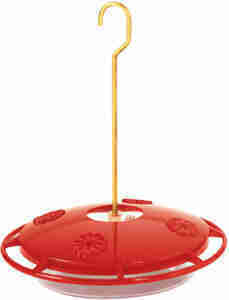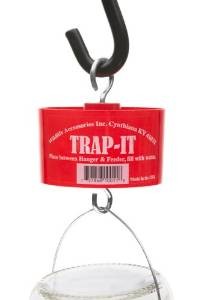Hummingbird Nectar Recipe: 1 part sugar to 4 parts water
Add 1 part sugar to 4 parts water. Stir to dissolve sugar as nectar comes to a boil. Boil 2 minutes. Let cool and add to feeder.
Making your own hummingbird nectar is a simple process that anyone can do and it will add to the enjoyment that you get from your hummingbird watching. It’s quick and will be healthier for the hummingbirds when you make your own nectar without the added food coloring.
Making your own hummingbird nectar only requires two ingredients, sugar and water. Making homemade hummingbird food will also save you money.
Hummingbird nectar formula:
The formula for homemade hummingbird food is 1 part sugar to 4 parts water. Ordinary white granulated table sugar and tap water is all you will need to make hummingbird food. Don’t use any honey, brown sugar, sugar substitutes, or red food coloring, nothing else needs to be added to the recipe for making your own hummingbird nectar.
The first step is to add the 4 parts of tap water to a pan and set it on the stove to bring it to a boil.
Next add the 1 part table sugar to the pan containing the boiling water and stir the mixture until the sugar is dissolved.
If you start with 4 cups of water, you will need to use 1 cup of regular white table sugar to get a 4 to 1 ratio. If you only want half as much hummingbird nectar you will use 2 cups pf water, and ½ cup of sugar. This will keep your 4 to 1 ration. A 4 to 1 ratio of water to sugar is used because that ratio is close to the ratio that is found actual flower nectar.
Boil the homemade hummingbird nectar for about 2 minutes. This 2 minute boiling time is required to boil out the chlorine if there is any in the water and will kill any impurities in the sugar that might cause it to spoil quicker.
Don’t boil the hummingbird food any longer that about 2 minutes or you will boil away too much water and change the 4 to 1 ratio and end up with a nectar that has more sugar than what occurs naturally in flower blooms. A higher sugar content will cause your hummingbird food to ferment quicker which means it will have to be changed sooner. A hummingbird nectar with a higher ratio of sugar will also be more likely to attract bees.
Once the hummingbird nectar has boiled for about 2 minutes and the sugar is dissolved, you can take it off the heat and let it cool to room temperature.
When your homemade hummingbird food has colled enough you can add it to your hummingbird feeder. If you have any nectar let over you can store it in the frig and continue to use it for up to 2 weeks.
The food in your feeder will have to be changed on a regular basis to keep it from fermenting and causing mold to grow inside your feeder. Hummingbirds won’t feed on moldy nectar and it’s hard to get out of your feeder.
If you see your hummingbird nectar is turning cloudy, that will be a sighn that it needs to be changed and replaced with fresh nectar.The amount of time your homemade hummingbird food formula will last before fermenting and need changing will vary depending on how hot the weather is. The general rule that you can go by is the cooler the weather and temperature outside, the longer the hummingbird nectar will stay fresh and the longer you can go without changing it.
The hotter the outside temperature, the quicker your hummingbird nectar will ferment and the sooner it will have to be changed to keep it from becoming moldy. You can keep an eye on the nectar to see when starts to turn cloudy, then change it.
Below is a general guide you might want to use to help determine how long your hummingbird food might stay fresh before needing to be replaced.
High temperatures Change nectar after
71-75 6 days
76-80 5 days
81-84 4 days
85-88 3 days
89-92 2 days
93+ change daily
Every time you change the homemade hummingbird nectar, rinse out your feeder with hot water. You will need to clean your feeder about once a week. The National Audubon Society says this should be done by rinsing with 1 part white vinegar to 4 parts water. Follow the vinegar wash by rinsing your hummingbird feeder at least three times with clear warm water before refilling.
If you happen to notice that mold has started to grow in your hummingbird nectar, because you didn’t change it soon enough, you will have to clean it with a stronger solution to kill the mold and sterilize your feeder.
Below is a good brush set to clean hummingbird feeders
 |
You will have to clean and sterilize your feeder by soaking your feeder in a mild bleach water solution. Soak your whole hummingbird feeder in a 10% bleach 90% water solution for an hour. You can purchase a set of brushes specially designed to clean hummingbird feeders. This will make your job a whole lot easier. It’s bound to happen sooner or later, so you might as well have the brushes on hand. |
After the hummingbird feeder is done soaking you should rinse it thoroughly 3 or 4 times with water. All traces of the bleach solution must be removed from inside the feeder.
Feeder cleaning will be a lot less work, if you start with a feeder that will allow you access to easily reach all the inside spots that need to be cleaned. Below is one such feeder.
Now that you know how to make your own hummingbird nectar, you will want to purchase a hummingbird feeder that is easy to take apart and easy to clean, and one that will also protect your homemade hummingbird nectar from insects that will also be attracted to the sweet nectar. Insects such as bees ants and wasps enjoy the taste also.
My favorite choice of easy to clean and insect resistant hummingbird feeders is the:
 Aspects 12oz Hummzinger Ultra With Nectar Guard.
Aspects 12oz Hummzinger Ultra With Nectar Guard.
It’s a great companion to use with your homemade hummingbird nectar
It’s inxpensive and It has several features that makes it well worth the price of only $28.18. (at the time this article was written)
The HummZinger has patented Nectar guard tips which are flexible membranes attached to the feed ports that prohibit entry from flying insects, but allow Hummingbirds to feed as usual. The HummZinger also has a built in ant moat that will stop crawling insects from getting to the nectar. It also has raised flower ports that divert rain. This is important to help keep out rain water that would dilute your hummingbird food.
This mid-size nectar feeder has a 12 oz. hummingbird nectar capacity and can be hung or post mounted with hardware provided. It has four feeding ports for hummingbirds to feed at and the feeder is constructed of unbreakable polycarbonate. A very easy to clean hummingbird feeder.
When you consider it’s ease of cleaning and it’s protection from bees, wasps and ants, this hummingbird feeder can’t be beat.
If you already have a hummingbird feeder of your own and you want to protect it from ants and other crawling insects, the ant moat below will keep ants and other crawling insects out of your nectar.

Trap-It Ant Moat for Hummingbird Feeders, Red
Product Description
The first and still the best to protect your Hummingbird and Oriole feeder from ants and other crawling insects. All you have to do is insert the ant moat between the hanger and the hummingbird feeder and fill with the ant moat with water. The water in the ant moat will be providing a barrier to crawling pests. The ant moat has a red color to attract hummingbirds to your feeder.
If you keep your hummingbird feeder clean and make sure your hummingbird nectar is always fresh, you should have no trouble attracting and keeping lots of hummingbirds at your feeder to watch. Enjoy watching your hummingbirds and I hope you enjoyed this article on how to make hummingbird nectar.
Click this link hummingbird nectar for more information on making homemade hummingbird food.
back to top of hummingbird nectar page.


